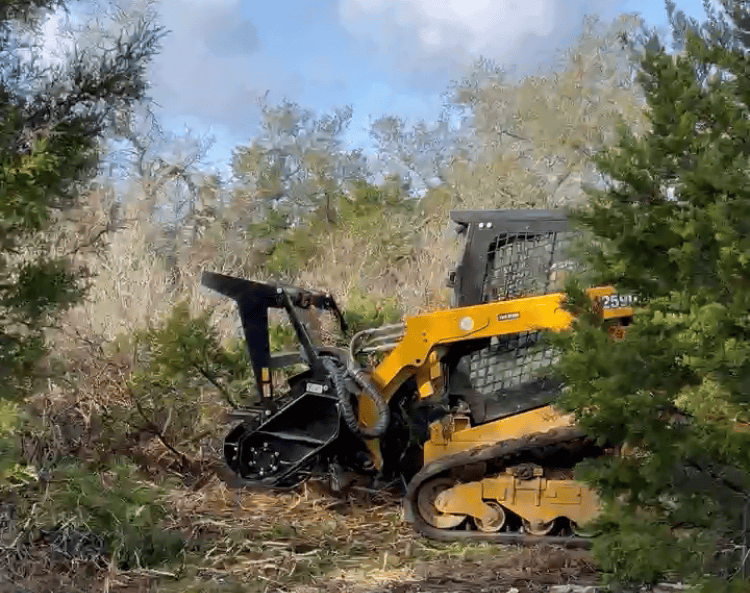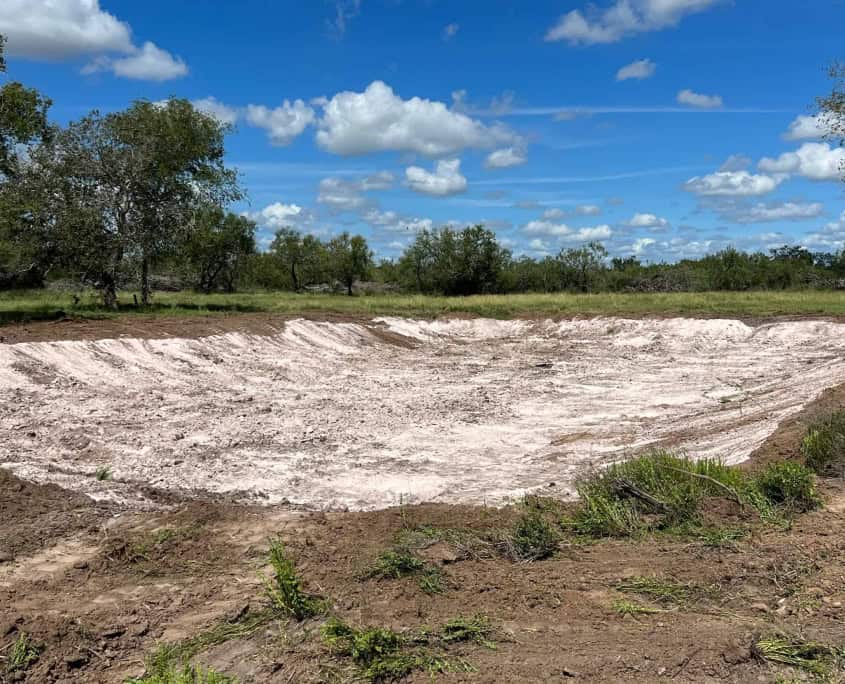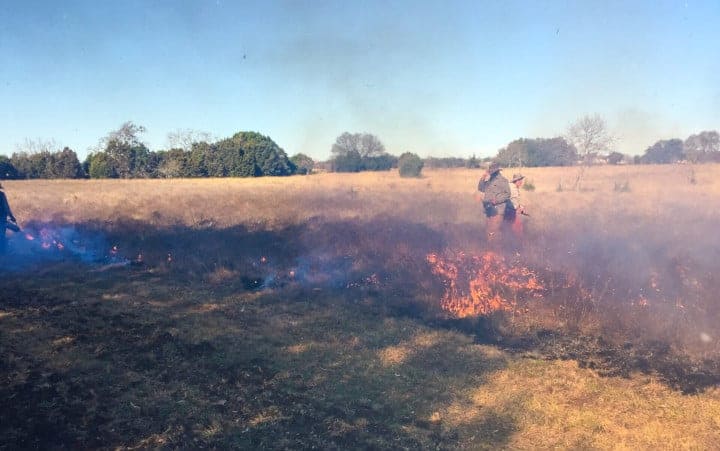Restoring Habitat for Endangered Songbirds with Travis County DNR
Priorities: Assess and Recondition 15 Acres to Prioritize Black-capped Vireo
Challenges: Evaluate Complex Habitat – Meet Tight Timeline Ahead of Nesting
Solutions: Task Expert Staff – Expedite with Key Equipment
The black-capped vireo is one of Texas’ most distinctive rare songbirds. And under a specific government directive, it receives protections based on monitoring in known habitats.
The bird left the endangered species list in 2018, but is now the focus of an “abundance monitoring” plan. Its relisting as “vulnerable” owed mostly to habitat restoration — which still has to happen on a regular basis.
Maas Verde undertook vireo habitat management on 15 acres of the Balcones Canyonlands National Wildlife Refuge (NWR) in northwest Austin. There, conflicting habitats between it and another threatened Texas songbird butted right up against each other.
The endangered golden-cheeked warbler roams a far different range than the black-capped vireo at large. But in Texas, their territories overlap. The birds often nest side-by-side, choosing different species that grow closely together in our area.
This situation demands precision and judgment from a land manager prioritizing one bird species or the other. Maas Verde’s job would be to optimize the habitat for black-capped vireos without chasing warblers away.
Natural Resources Specialist Paul Fushille led the project for the Travis County Department of Natural Resources (DNR).
“The area just looked like a wall of brush at the start of the project,” Fushille said. “Any casual onlooker wouldn’t have been able to make any sense out of it. This required strong skills in species identification and forestry mowing.”
Habitat Circumstances
Vireos tend to nest in thickly-clumped shrubby vegetation like shin oak (Quercus grisea), evergreen sumac (Rhus virens), and flameleaf sumac (Rhus lanceolata) at heights of about 3-6 feet. Golden-cheeked warblers like to nest relatively high up in mature Ashe juniper trees that stand alone.
The Balcones Canyonlands NWR parcel that Maas Verde treated was a tangle of these habitats. And due to the relative maturity of the landscape, which had gone unmanaged for around a decade, it was no longer harboring vireos effectively.
Instead of post-oak savannah, with clumped vegetation surrounded by open areas, it was becoming denser.
“A lot of the shin oak and flameleaf sumac — the shrubby species — had actually matured into tree-like structures,” Maas Verde project manager Marc Opperman said. “Essentially, it was aging out of what the black-capped vireo prefers.”
Project Outline
Close surveillance by Fushille and his team dictated expectations on the project. They monitored the local vireo population using coded ankle bands to track the birds’ nesting locations and movement patterns.
“When we started monitoring this area in the mid-1990s, we had around 20-22 birds,” Fushille said. ” But because the area had not been managed for some time, those numbers were declining.”
Maas Verde’s treatment would occur at the very end of the viable season. The birds’ protected mating season runs from March 1 to July 31. During that time, heavy equipment use is prohibited in their area under take regulations.
Multiple obstacles, like February’s damaging ice storm, delayed Maas Verde’s restoration work until late in the month.
The distribution of species and general brush density on the land forced Maas Verde to create “lanes.”
“This wasn’t a clear cut. Instead, we would judiciously look at pockets of vegetation and particular trees — especially Ashe junipers and big oaks — and treat those as islands, managing the surrounding species,” Opperman explained.
Attention to the detail of Fushille’s spec guided this approach.
“We’d had previous companies come in that removed a little too much [brush],” Fushille said. “Clear cutting is pretty common at this scale of land management in our area. It’s what a lot of ranchers want. Grassland for livestock, etc. But we needed more habitat evaluation.”
Implementation and Challenges
Hitting the Target Boundary
The Balcones Canyonlands NWR is huge. At 32,000+ acres, it is larger than the city of Round Rock.
It was important for Opperman and the crew to treat only the target area. To facilitate this, Fushille uses an app that combines GIS location services with PDF maps his team created internally. The Maas Verde crew could track their locations inside the project boundary with their phones.
“They picked up the app and ran with it,” Fushille said. “Technical literacy was no problem.”
Detailed Treatment
Opperman and the crew developed a system and worked quickly, without removing too much brush.
For instance, the crew might “top” (or trim to height) an overgrown flameleaf sumac. A ground crew with chainsaws would cut the shrub to a suitable height for vireo nesting. Then Opperman would mulch the excess with the forestry mower.
By design, the process would encourage the low, radiating growth that vireos prefer.
Two key challenges placed the strictest demands on Opperman’s skill and resources. First, identifying one woody species from another without any leaves to compare. Second, balancing the ecosystem’s holistic health against the vireo prioritization.
He met the first challenge with resolute dedication to Texas wildlife. A certified Master Naturalist since 2012, Opperman is an energetic student of local species.
Meeting the second came down to applying those skills.
“Every time I looked at a particular area, I had to make a decision. Is this great habitat that just needs to be cleaned up a little bit? Is there anything significant that I need to remove completely, because if we just mow it down, it will come back up again and impair the habitat? Or should we be opportunistic and mow one species, say a young juniper, that won’t necessarily attract vireos and also won’t grow back even if we don’t pull it from the roots?”
Project Manager Marc Opperman
Efficiency
Evaluating an overgrown, 15-acre area one tree at a time would be painstaking. So efficient implementation was key.
Opperman ran the mower in “pirouettes” around mature trees to create lanes. Ground personnel directed by crew leader Juan Carlos Hidalgo worked in close proximity. Maas Verde tasked the same staff throughout the project to fuel the accuracy and efficiency of the treatment.
The crew averaged 10-hour shifts to finish the project in 10 days, working around one skid steer breakdown. The DNR also added two acres onto the scope during the project.
“I went into it not expecting to get it all done,” Fushille said. “You run into issues you can’t predict on every project. Maas Verde encountered and overcame these, and surprisingly, covered the entire area in this short window.”
 Opperman managing the preserve lands with a forestry mower; (photo/Maas Verde)
Opperman managing the preserve lands with a forestry mower; (photo/Maas Verde)
Results
Fushille’s team does not expect black-capped vireo numbers to recover on the treated land for several more nesting seasons. That’s because the birds generally avoid disturbed areas. However, Fushille spoke to the engineered habitat’s suitability.
“Marc came in fully understanding the vision, and our land management requirements. There was a lot of really good communication,” he said. “That showed in the final result. Our team surveyed the property all nesting season, because even though we didn’t expect any vireos to return there, it looked like such good habitat.”
The preserve will need ongoing management to support black-capped vireos. And because of habitat loss, engineered tracts like the Balcones Canyonlands NWR acreage will remain important.
“We know we’re going to have to do this again in five to eight years,” Fushille said. “Maas Verde is the first group to come in and do mechanical treatment at the NWR on this wide of a scale. It’s hard to make this kind of treatment perfect, but the crew was able to leave a lot of really, really good habitat behind.”
If you’re lucky enough to come across a black-capped vireo nest, you’ll see they both stand out and blend in. The birds make cup-shaped nests with a wide variety of materials including spider silk and Ashe juniper bark, often garlanded with strips of green lichen. Find them several feet off the ground — placed securely within their preferred shrubby species.
*Featured image: Black-capped vireo in the Balcones Canyonlands NWR; (photo/Isaac Sanchez via Flickr)




